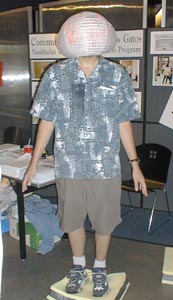![[MetroActive Features]](/features/gifs/feat468.gif)
[ Features Index | San Jose | MetroActive Central | Archives ]
 Spin Doctors
Spin Doctors
Treating virtual motion sickness out at the Tech Museum By Will Harper
'WHAT I WANT YOU to do first," Los Gatos Community Hospital occupational therapist and balance specialist Elizabeth Youngman instructs me, "is to stand with your feet next to each other." No problem, I think. Youngman, dressed in white polo shirt and khakis, examines the black Cronus stopwatch hanging from her neck and after 30 seconds informs me that the first balance test is done. I have passed, which means I have performed the amazing physical feat of not swaying like a drunken sailor at a Tijuana strip joint waving a grimy dollar bill in his hand. "Now," she warns, "it's going to get a little harder." This time, she tells me, I must stand with my feet side-by-side once again for 30 seconds--but with my eyes closed. Whoa. This is harder, I muse. A little swaying. As I often do when something surprises me, I switch my internal monologue to hyperlogical Mr. Spock mode: "Fascinating, captain. The absence of visual stimuli has affected my ability to stand still." Apparently, this is the point of the exercise. People use visual markers, Youngman informs me, to help keep their balance. In the absence of visual cues, she says, we must rely on our inner ear for balance; if a person has a balance disorder like vertigo--called a vestibular disorder--he or she will battle mightily to stand straight without getting dizzy. Fascinating. But there is more. The next test: Standing with feet together and eyes closed on a 4-inch-thick cube of foam for 30 seconds. This time I am determined to be more focused. In spite of the squishy firmament below my Rockports, I remain relatively still. I am focused. I strive to remember: what was that book I had to read for an art class in college? Oh, yes: Zen and the Art of Archery. Something about becoming one with the object, target or motorcycle clutch. I do it and find no problem here. On to the next test, I say! And then that's when they hand me the lampshade. A translucent Chinese lantern, to be exact. Inside the lantern some mischievous soul has splattered a Froot Loop variety of colors. I suspect that this alleged "test" is Elizabeth and her colleagues' way of getting a good chuckle at my expense for their public demonstration today at the Tech Museum. But this is indeed a real clinical balance exercise done to help rehabilitate those who suffer from inner-ear disorders. The lampshade test, says Los Gatos Community Hospital physical therapist Joyce Chadderdon, shows how people adjust their balance when their eyes send the brain conflicting information. Chadderdon and Youngman are at the Tech today primarily to help patrons recover their equilibrium after seeing Thrill Ride, which through virtual-reality technology re-creates the feeling of riding roller-coasters and other amusement park rides. The trick to alleviating motion sickness, virtual or otherwise, Chadderdon says, is to sit still with hands and feet firmly pressed against the chair and floor. This sends a message to the brain that the roller coaster ride is finished. But many people don't need a trip on Thrill Ride to get dizzy. For those with inner-ear disorders, merely sitting up in bed in the morning can be enough to get the room spinning. According to statistics cited by the Oregon-based Vestibular Disorders Association (vestibular.org), dizziness is among the 25 most common reasons Americans go to the doctor every year (about 5 million visits). Though medical experts don't always know what causes balance disorders, common culprits include strokes and head trauma. When doctors in the area diagnose patients with an inner-ear disorder, they often send dizziness-sufferers to the Vestibular and Balance Disorders Rehabilitation Program in Los Gatos, where Youngman and Chadderdon work. Chadderdon says that it usually takes a patient about 10 weekly visits over a three-month period to overcome dizziness. By repeating balance exercises like the lampshade test--called habituation exercises--patients readapt their brains so rooms don't spin anymore. Like any other rehab program, this one isn't always a pleasant experience. "Some people actually get to the point," she says, "that they vomit." Lovely. Before I leave, Chadderdon subjects me to one final test. For this one I march in place with my eyes closed for 50 counts. At least I'm supposed to march in place. When I'm done I find myself four feet from where I started. Usually, people only move one foot. But, hey, I tell myself--at least I didn't vomit. [ San Jose | MetroActive Central | Archives ]
|
From the November 4-10, 1999 issue of Metro, Silicon Valley's Weekly Newspaper.
Copyright © 1999 Metro Publishing Inc. MetroActive is affiliated with the Boulevards Network.
For more information about the San Jose/Silicon Valley area, visit sanjose.com.